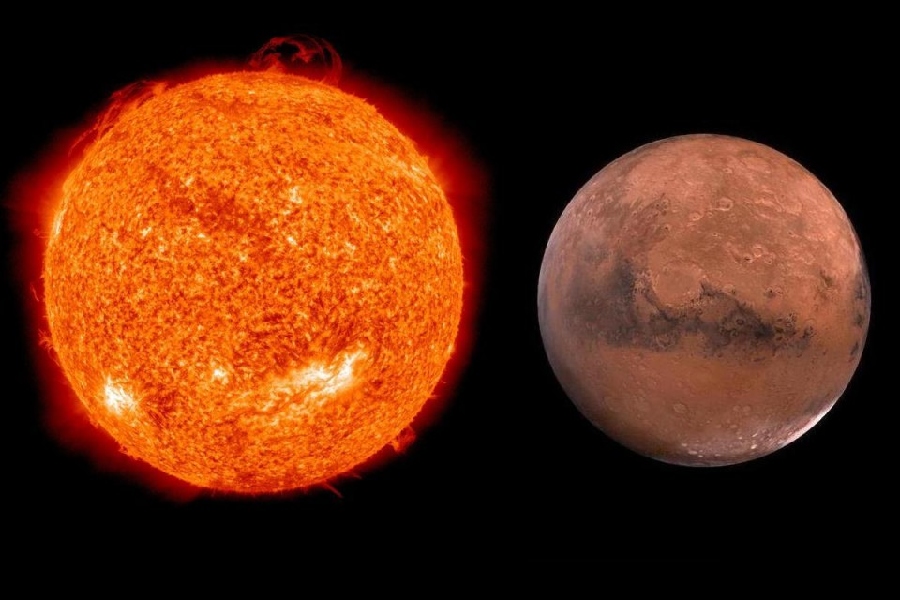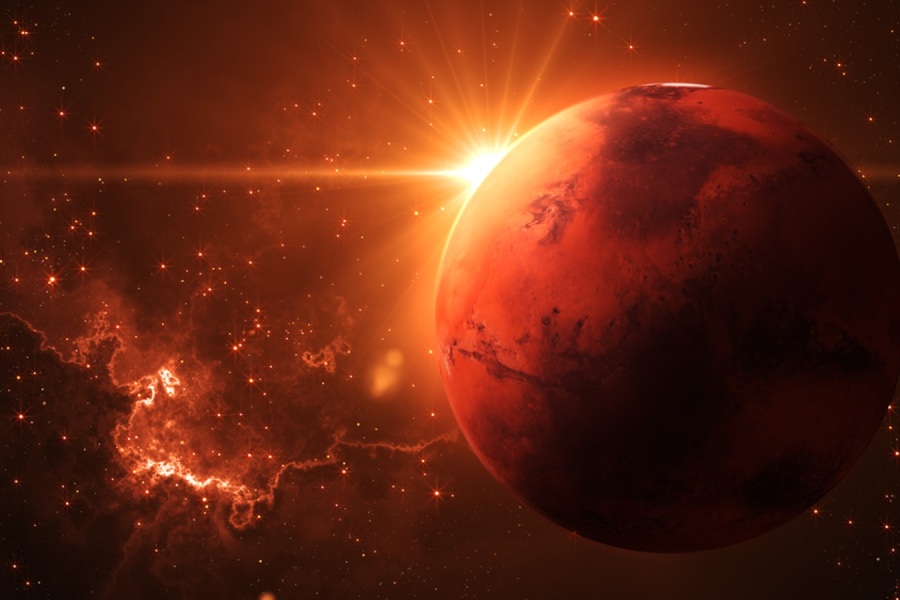Our Solar System’s fourth planet Mars often gets labeled as “Red Planet”. But how does it size up against the Sun that warms it? Everyone knows the Sun is bigger than Mars, but by how much exactly? This article will analyze and visualize the red planet Mars, compared to the Sun, our stalwart star.
We will investigate the staggering scale differences between Mars and the Sun based on established astronomical data. The concepts covered will include relative diameters, volumes, masses, densities, and more.
We will explore phenomena unique to the Sun, like solar flares, and illuminate the stark contrasts between a star and a planet. This knowledge will foster an appreciation for the diversity of Mars compared to the Sun.
This comparative guide will unpack the significant contrasts between these celestial neighbors – one a small, rocky planet and the other a massive, swirling star.

Mars Compared to the Sun
Mars and the Sun are vastly different celestial bodies. Mars is a terrestrial planet, smaller and colder than Earth, with a thin atmosphere and diverse surface features. In contrast, the Sun is a massive, hot, luminous ball of plasma, the central body of our solar system.
Mars orbits the Sun as a planet, dependent on the Sun’s gravitational pull, but in terms of size, composition, and nature, the two are distinct entities with unique roles in our cosmic neighborhood.
Overview of Mars
Mars as a Terrestrial Planet
Mars is the fourth planet from the Sun and the second smallest planet in our solar system. It is a terrestrial planet, meaning it has a solid surface made up of minerals and rocks. Learning about Mars gives insight into the formation and evolution of rocky planets like Earth.
Key characteristics
Mars has a reddish, rusty appearance due to iron oxide on its surface. It has two small moons called Phobos and Deimos. Mars’ atmosphere is very thin compared to Earth’s. This means it cannot retain heat very well, resulting in colder surface temperatures.
Mars’ axial tilt and rotation period also give the planet seasons and days similar in length to those on Earth. The red planet’s characteristics, like potential evidence of ancient water flows, have driven much scientific interest regarding habitability. So, since Mars has similarities with our Earth, it’s only natural for scientists to believe in Mars as a promising place to search for life beyond Earth.
Mars’ composition and structure
Mars has a dense metallic core composed of iron, nickel, and sulfur. Surrounding the core is a rocky mantle and crust made up of elements like silicon, oxygen, and magnesium. The crust averages about 50 kilometers thick. Understanding Mars’ internal structure provides clues to how terrestrial planets form.
Importance of Studying Mars in Planetary Science
Studying Mars gives critical insights into the geological processes shaping rocky planets. Its surface shows signs of ancient oceans and volcanoes.
It also reveals evidence that Mars once had a much thicker atmosphere and liquid water. Mars serves as a planet for further analysis and discoveries. By analyzing its soil and climate deepens knowledge of how life may arise on other planets.
Mars is significantly smaller than the Sun, but twice the size of Earth’s moon. Determining its precise dimensions has been an important part of assessing Mars’ suitability for habitation.
Mars’ diameter, radius, and mass measurements
Mars has a diameter of about 6,792 km compared to Earth’s 12,742 km. Its polar radius spans 3,390 km versus Earth’s 6,357 km. Weighing in at 6.4171 x 10^23 kg, Mars has only 10.7% of the mass of Earth. These smaller dimensions and mass shape Mars’ reduced gravitational pull and density compared to Earth’s.
The considerable differentials in size, mass and density have implications for Mars’ ability to retain atmosphere.
Features and physical attributes of Mars’ surface
Mars is home to immense volcanoes and canyons. Valles Marineris is over 4,000 km long and 7 km deep. Olympus Mons is the largest known volcano, towering 22 km high. Frozen water makes up the polar ice caps. Dust storms can engulf the entire planet due to its dry, rocky terrain.
Overview of the Sun
Solar characteristics and solar structure
The Sun is a yellow dwarf star and the center of our solar system. It contains 99.8% of the solar system’s mass and provides nearly all its light and heat. Nuclear fusion in the Sun’s core causes it to shine brightly. Studying the Sun provides insight into the lifecycle of stars.
The Sun’s stability enables life in the solar system. Its consistent energy output and circumsolar position define ideal habitable zones for rocky inner worlds like Earth to evolve complex biospheres. As the solar system’s central engine, the Sun powers dynamics from planetary orbits to weather systems.
Composition and layers of the Sun
The Sun is composed of hydrogen and helium gas. Its internal structure consists of the core, radiative zone, convection zone, photosphere, and atmosphere.
Each layer has distinct properties due to differences in temperature and solar material. Understanding the solar interior reveals stellar evolutionary processes. The layered structure influences dynamic solar activity.
Sun’s diameter, radius, and mass
The Sun’s diameter is 1,392,684 km, over 100 times wider than Earth’s. Its radius is 695,508 km compared to Earth’s paltry 6,371 km. At 1.989 x 10^30 kg, the Sun contains 99.86% of all solar system mass.
These enormous dimensions and mass create tremendous gravitational force. The statistics quantify the Sun’s sheer scale and central dominance.
Solar influence and importance in the solar system
The Sun’s tremendous mass generates an enormous gravitational field spanning the solar system. This influence keeps the planets and other bodies orbiting the Sun. The Sun also emits solar wind, a stream of charged particles blowing out across the system.
The solar wind shapes planetary magnetospheres and atmospheres. The Sun’s gravity and solar wind make it the primary sculptor of the solar system.
Role of the Sun in planetary dynamics and systems
The Sun’s gravity controls the movements of solar system bodies. Its radiation powers weather systems and climate on planets through heating. Solar flares and sunspots can disrupt planetary environments and electronics via magnetic energy.
The Sun’s regular rhythms create stability for life to arise and evolve. Variability in solar activity causes fluctuations in planetary systems.
Solar impact on Mars and other planets
On Mars, the Sun drives seasons, ice cap shrinkage, dust storms, and the possible presence of liquid water. Venus and Mercury experience extreme heating and expansion effects from solar proximity.
The Sun energizes Jupiter’s and Saturn’s magnetospheres and causes auroras. Solar influence shapes everything from daily temperature swings to long-term climate patterns on planets.

Contrasting Mars and the Sun: Size and Dimensions
As an Earth-like rocky planet, Mars is relatively small in the context of the solar system. Precisely determining Mars’ size has helped reveal its composition and internal structure.
Multiple methods have been used over time to measure the planet. Understanding Mars’ dimensions provides insights into its formation and evolution.
As a stable yellow dwarf star, the Sun comprises over 99% of the solar system’s mass, generating copious light and heat through fusion reactions in its core.
The Sun’s stellar attributes and consistent output foster Earth’s habitability at an optimal orbit for liquid surface water. Driving seasons and climate patterns through phenomena like solar winds and flares also motivates protective space weather research and modeling.
Historical and modern techniques in measuring Mars’ dimensions
Early Mars diameter estimates using telescopic sightings have been refined by precision radar scans, orbital imaging craft, and laser surface altimetry that reveal the red planet has around half the size and mass of Earth.
These accurate measurements enhance our understanding of Mars’ lower density and gravity relative to our own planet. They shed light on internal composition and dynamic forces that influenced Mars’ evolution into a frigid desert compared to Earth’s sustaining environment.
Solar size and comparison with Mars
Compared to tiny Mars, the Sun is gigantic. Mars looks like a tiny speck of dust beside the enormous Sun star.
The Sun has 99.8% of all the material in our whole solar system inside it. This shows how incredibly huge stars are next to even big planets. It makes clear how stars like our Sun totally dominate over puny planets in size and mass.
Enormity of the Sun’s diameter, radius, and circumference
The Sun’s diameter is 1,392,684 km—over 200 times Mars’ size. Its radius is 695,508 km compared to Mars’ 3,390 km. The Sun’s circumference at its equator equals 4,370,005 km.
These giant dimensions reflect the Sun’s role as the dominant celestial body in our solar system. The sheer scale enables the Sun’s influential gravitational field and energy output.
Visualizing the vast difference between Mars and the Sun
While Mars has a solid, rocky surface, the Sun is a churning ball of plasma and gas. Fitting over 960,000 Mars-sized planets across its diameter illustrates the Sun’s sheer scale compared to the tiny fourth planet. Their sizes differ by orders of magnitude.
Mars and the Sun: Comparative Characteristics
Contrast in mass and gravity
With a mass only 0.107 times Earth’s, Mars has far less mass than the Sun, which has 99.8% of all solar system matter. This huge mass difference affects their gravity properties. Mars has a mass of 6.4171 x 10^23 kg. The Sun’s mass is 1.989 x 10^30 kg—over 300,000 times bigger than Mars. This makes solar gravity much stronger.
Solar energy and heat influence on Mars
The Sun provides nearly all the light and heat energy in the solar system. Mars receives only around 43% of the solar energy Earth absorbs due to its greater distance.
Mars’ axial tilt exposes some regions to more direct sunlight during seasons. Solar heating drives Martian weather patterns and ice cap changes. It also powers dust storms engulfing the entire planet.
Impact of solar energy on Mars’s climate and atmosphere
Solar energy influences atmospheric thickness, temperature swings, and climate cycles on Mars over long timescales. Past solar variations likely helped Mars transition from a wet world to today’s frozen, dry landscape, highlighting the profound impact of solar energy on the planet’s geological history.
Importance of comparing Mars to the Sun
Contrasting tiny Mars with the enormous Sun illustrates solar system scale and dynamics. It provides perspective on a planet’s significance relative to its central star. Comparing sizes shows how the Sun’s mass dominates planets and controls their motions and stability.
The size difference informs theories of solar system origins and planet birth. It explains the Sun’s gravitational central role and the impacts of solar wind on planets, influencing atmospheric and geological processes as well as broader heavenly interactions.
Studying solar effects on Mars reveals climate links between stars and planets. It grows knowledge of climate systems, livability, and stellar energy’s role. The Sun guides Mars’ seasons, powers air changes, and may have permitted past liquid water.

Conclusion
By exploring key traits like size, mass, and energy output, we can illuminate the dramatic differences between celestial bodies, even neighbors like Mars and the Sun.
This comparison has shown the enormity of our Sun relative to small, rocky planets and revealed its central role in governing planetary motions and climates. We hope this article has helped convey the scale and diversity of objects that make up our solar system.
Appreciating the contrasts between tiny Mars and the behemoth Sun is enlightening. It enhances our knowledge of how these distinct celestial bodies influence and rely on each other across vast distances.
With this improved understanding of our stellar neighborhood. You can continue exploring space with greater awareness of the Sun-planet relationships that make life possible. We hope you have better clarity about the key differences between Mars compared to the Sun.
